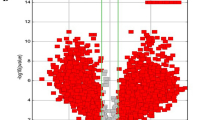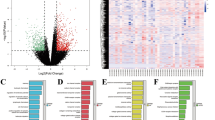Abstract
Background
Gestational diabetes mellitus (GDM) reflects a deficiency in the relative need for insulin during pregnancy, as well as temporary metabolic stress in the placenta and fetus. Our study aimed to research the potential diagnostic value of transforming growth factor-beta-induced protein ig-h3 (TGFBI) and transforming growth factor beta-2 proprotein (TGFB2) for GDM patients.
Methods
Online database Gene Expression Omnibus (GEO) was used to screen for different expressed genes (DEGs) associated with GDM. Meanwhile, KEGG and GO were used to analyze the molecular functions as well as pathways of enriched DEGs. One hundred ten pregnant women diagnosed with GDM and 110 healthy controls were enrolled, of whose placenta and fasting venous blood samples were collected. mRNA expression levels were determined by real-time quantitative polymerase chain reaction (RT-qPCR), and fasting blood glucose (FBG) was measured by the clinical lab of hospital. Furthermore, receiver operating characteristics curve (ROC) analysis was performed to evaluate the sensitivity and specificity of detection indexed in the placenta and plasma of GDM patients. Finally, Pearson and Spearman analysis was used for the correlation analysis.
Results
After GEO data analysis, TGFBI and TGFB2 were identified as the most significantly up-regulated genes of GDM. TGFBI and TGFB2 expressions in placenta and plasma samples of GDM patients were in line with bioinformatic analysis. Meanwhile, the area under the curve (AUC) of TGFBI in the placenta and plasma for the diagnosis of GDM were 0.8783 (95% CI, 0.8281 to 0.9284) and 0.7832 (95% CI, 0.7215 to 0.8449) while for TGFB2 were 0.9225 (95% CI, 0.8829 to 0.9621) and 0.8961 (95% CI, 0.8526 to 0.9396). Besides, levels of TGFBI along with TGFB2 in the placenta were positively correlated with that in the plasma of GDM patients. Furthermore, both TGFBI and TGFB2 expressions in the plasma were positively correlated with FBG levels of the GDM patients.
Conclusions
TGFBI and TGFB2 were up-regulated in the placenta and plasma of GDM patients, and TGFBI and TGFB2 in the plasma are potent to be diagnostic markers for the GDM.







Similar content being viewed by others
References
Szmuilowicz ED, Josefson JL, Metzger BE (2019) Gestational diabetes mellitus. Endocrinol Metab Clin North Am 48(3):479–493
Coustan DR (2013) Gestational diabetes mellitus. Clin Chem 59(9):1310–1321
Alfadhli EM (2015) Gestational diabetes mellitus. Saudi Med J 36(4):399–406
Johns EC et al (2018) Gestational diabetes mellitus: mechanisms, treatment, and complications. Trends Endocrinol Metab 29(11):743–754
Sargin MA et al (2016) Neutrophil-to-lymphocyte and platelet-to-lymphocyte ratios: are they useful for predicting gestational diabetes mellitus during pregnancy? Ther Clin Risk Manag 12:657–665
Buchanan TA, Xiang AH, Page KA (2012) Gestational diabetes mellitus: risks and management during and after pregnancy. Nat Rev Endocrinol 8(11):639–649
Li ZH et al (2018) Galectin-9 alleviates LPS-induced preeclampsia-like impairment in rats via switching decidual macrophage polarization to M2 subtype. Front Immunol 9:3142
Lin F et al (2020) The maternal-fetal interface in small-for-gestational-age pregnancies is associated with a reduced quantity of human decidual NK cells with weaker functional ability. Front Cell Dev Biol 8:633
Li Y et al (2021) Roles of TGF-beta superfamily proteins in extravillous trophoblast invasion. Trends Endocrinol Metab 32(3):170–189
Young VJ et al (2017) The role of TGF-beta in the pathophysiology of peritoneal endometriosis. Hum Reprod Update 23(5):548–559
Yao Y et al (2019) Exosomes derived from mesenchymal stem cells reverse EMT via TGF-beta1/Smad pathway and promote repair of damaged endometrium. Stem Cell Res Ther 10(1):225
Ni N, Li Q (2017) TGFbeta superfamily signaling and uterine decidualization. Reprod Biol Endocrinol 15(1):84
Xu Y et al (2020) Polymorphisms of TGF-beta1 and TGF-beta3 in Chinese women with gestational diabetes mellitus. BMC Pregnancy Childbirth 20(1):759
Marcantoni E et al (2015) Dysregulation of gene expression in human fetal endothelial cells from gestational diabetes in response to TGF-beta1. Prostaglandins Other Lipid Mediat 120:103–114
Al SZ et al (2018) Protective effect of stromal Dickkopf-3 in prostate cancer: opposing roles for TGFBI and ECM-1. Oncogene 37(39):5305–5324
Yang B et al (2020) TGFB2 serves as a link between epithelial-mesenchymal transition and tumor mutation burden in gastric cancer. Int Immunopharmacol 84:106532
Wang BJ et al (2019) TGFBI promotes tumor growth and is associated with poor prognosis in oral squamous cell carcinoma. J Cancer 10(20):4902–4912
Schorderet DF et al (2000) Genomic characterization and embryonic expression of the mouse Bigh3 (Tgfbi) gene. Biochem Biophys Res Commun 274(2):267–274
Ciriza J, Garcia-Ojeda ME (2010) Expression of migration-related genes is progressively upregulated in murine Lineage-Sca-1+c-Kit+ population from the fetal to adult stages of development. Stem Cell Res Ther 1(2):14
Takahashi H et al (2019) TGF-beta2 is an exercise-induced adipokine that regulates glucose and fatty acid metabolism. Nat Metab 1(2):291–303
Author information
Authors and Affiliations
Corresponding author
Additional information
Publisher's Note
Springer Nature remains neutral with regard to jurisdictional claims in published maps and institutional affiliations.
Rights and permissions
About this article
Cite this article
Zhou, H., Chen, P., Dai, F. et al. Up-regulation of TGFBI and TGFB2 in the plasma of gestational diabetes mellitus patients and its clinical significance. Ir J Med Sci 191, 2029–2033 (2022). https://doi.org/10.1007/s11845-021-02838-2
Received:
Accepted:
Published:
Issue Date:
DOI: https://doi.org/10.1007/s11845-021-02838-2




